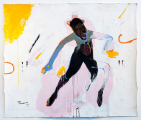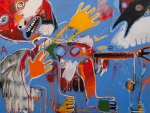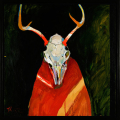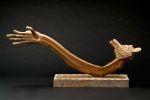Rick Bartow is one of Oregon’s best-known artists. For more than 40 years, he has created a powerful body of work, influenced by his Native American heritage, life experiences, physical environment, international travels and fine art training. In 2012, two of his monumental sculptures were permanently installed on the National Mall in Washington, D.C., outside the Smithsonian’s National Museum of the American Indian.
Rick Bartow: Things You Know But Cannot Explain opens January 24 and runs through April 24, 2016 at Gilcrease Museum. Featuring more than 100 pieces, including a broad selection of sculptures, paintings, drawings, prints, mixed media work and the giant pastels for which he is mostly known, the exhibition draws from public and private collections (including the artist’s studio) that affirm this extraordinary artist’s regional, national and international impact. The exhibition culminates in outstanding examples of Bartow’s most recent work, which evidences a new freedom of scale and expression.
Born in Newport, Oregon, in 1946, Bartow is a member of the Wiyot tribe of Northern California and has close ties with the Siletz community. Bartow studied art at Western Oregon State College – now Western Oregon University – in Monmouth, where he graduated in 1969 with a degree in secondary arts education. That same year he was drafted and sent to Vietnam. He served in the Vietnam War from 1969-71.
Bartow has worked with printmakers around the world and has traveled as an artist to Japan, Germany, Mexico and New Zealand. Bartow’s influences are as broad as Marc Chagall, Francis Bacon, Odilon Redon and Horst Janssen, in addition to his Native American heritage and his work with the Māori people.
His work has been featured in many solo and group exhibitions nationally and internationally and is in numerous public and private collections including the Portland Art Museum, the Hallie Ford Museum in Salem, the Eiteljorg Museum of American Indians and Western Art in Indianapolis, the Peabody Essex Museum, the Heard Museum, Phoenix and the Portland Art Museum.
A milestone for Bartow came in 2012 when he installed his We Were Always Here sculptures, two large carved western red cedar poles reminiscent of totems at the National Museum of the American Indian, who commissioned the work.
Gilcrease Museum will be the first venue for Rick Bartow: Things You Know But Cannot Explain outside of the west coast.
The exhibition is co-curated by Jill Hartz, executive director of the Jordan Schnitzer Museum of Art, University of Oregon, and Danielle Knapp, McCosh Associate Curator at Jordan Schnitzer Museum of Art. In addition to showing the artist’s most recent work, the exhibition and catalog explore key themes in the artist’s oeuvre: “Gesture,” “Self,” “Dialogue,” “Tradition,” and “Transformation” and “New Work.” This is the first major exhibition to feature such diverse examples of his work, including many of Bartow’s graphite drawings from the late 1970s and large-scale wood and mixed media constructions.
The exhibition is accompanied by a fully illustrated catalog with essays by the curators and Lawrence Fong, former curator of American and regional art at the JSMA. The show is traveling to other venues in addition to Gilcrease, including the IAIA Museum of Contemporary Native Arts, Santa Fe; The Heard Museum; Washington State University Museum of Art, Pullman; and The Autry National Center, Los Angeles.
Organized by the Jordan Schnitzer Museum of Art, University of Oregon.
Support for the exhibition is provided by the Ford Family Fund of the Oregon Community Foundation, Arlene Schnitzer, the Coeta and Donald Barker Changing Exhibitions Endowment, The Harold and Arlene Schnitzer CARE Foundation, a grant from the Oregon Arts Commission and the National Endowment for the Arts (a federal agency), the Ballinger Endowment, Philip and Sandra Piele and JSMA members.
Title sponsor of the Gilcrease Museum 2016 exhibition season is the Sherman E. Smith Family Foundation, with support from the Mervin Bovaird Foundation.








